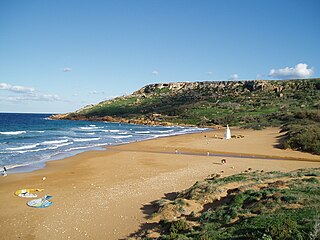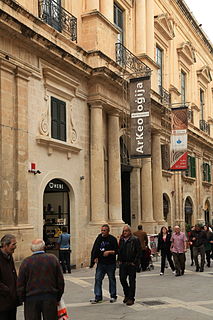
Malta, officially known as the Republic of Malta, is an island country of the European Union consisting of an archipelago in the Mediterranean Sea, and considered part of Southern Europe. It lies 80 km (50 mi) south of Sicily (Italy), 284 km (176 mi) east of Tunisia, and 333 km (207 mi) north of Libya. The official languages are Maltese and English, and 66% of the current Maltese population is at least conversational in the Italian language.

Ġgantija is a megalithic temple complex from the Neolithic on the Mediterranean island of Gozo in Malta. The Ġgantija temples are the earliest of the Megalithic Temples of Malta and are older than the pyramids of Egypt. Their makers erected the two Ġgantija temples during the Neolithic, which makes these temples more than 5500 years old and the world's second oldest existing manmade religious structures after Göbekli Tepe in present-day Turkey. Together with other similar structures, these have been designated a UNESCO World Heritage Site, the Megalithic Temples of Malta.

Siġġiewi, also called by its title Città Ferdinand, is a city and a local council in the South Western Region of Malta. It is the third largest council in Malta by surface area, after Rabat and Mellieħa respectively. It is situated on a plateau, a few kilometres away from Mdina, the ancient capital city of Malta, and 10 kilometres away from Valletta, the contemporary capital. It is the home of 8367 inhabitants as of March 2014.

Żebbuġ is an administrative unit of Malta, in the northwest coast of the island of Gozo. It is located close to Għarb and Għasri and is built on two hilltop plateaus, Ta' Abram and Ix-Xagħra taż-Żebbuġ. The fishing port and tourist resort of Marsalforn lies within the Żebbuġ Council. The village has a population of 2,956, which makes it the fifth largest in Gozo, after Xewkija.

The Hypogeum of Ħal Saflieni is a Neolithic subterranean structure dating to the Saflieni phase in Maltese prehistory, located in Paola, Malta. It is often simply referred to as the Hypogeum, literally meaning "underground" in Greek. The Hypogeum is thought to have been a sanctuary and necropolis, with the remains of more than 7,000 people documented by archeologists, and is among the best preserved examples of the Maltese temple building culture that also produced the Megalithic Temples and Xagħra Stone Circle.

The Xagħra Stone Circle, also known as the Xagħra Hypogeum or the Brochtorff Circle, is a Neolithic funerary complex located in Xagħra, Gozo, Malta. It consists of a series of caves which were used to bury the dead, and which were surrounded by a walled enclosure. It mainly dates back to around 3000 to 2400 BC, although the earliest tombs at the site date back to 4100 to 3800 BC. The caves collapsed sometime before 2000 BC, and the site was later used for domestic and agricultural purposes.

Ramla Bay is located at the bottom of a rich and fertile valley on the northern side of the island of Gozo. Gozo is one of the Maltese islands. The village of Xagħra, located on one of the hills of Gozo, overlooks this valley. It is about a forty-minute walk from Xagħra to the bay. The bay can also be reached from the village of Nadur. Bus service to the beach is very regular. The terraced walls built by the farmers give the valley an appearance of a quilt when viewed from the high ridges surrounding it.

Xagħra is an administrative unit of Malta, on the island of Gozo. It is one of the earliest inhabited parts of Gozo, being home to the Ġgantija megalithic temples which date back to the year 3600BC and the Xagħra Stone Circle. Natural underground features such as Xerri's Grotto and Ninu's Cave can be found in this town, along with Calypso's Cave which overlooks the red sandy beach of Ramla. It is one of the largest towns in Gozo and is situated to the North-East of the Gozo capital Victoria, having a population of 4,129 inhabitants as of January 2019. Xagħra is a popular tourist attraction, in view of its historical heritage, lively Victory Square, and the thousands who flock to Ramla Bay in summer and to the temples all year round. During the British period, Xagħra was also known as Casal Caccia.

Nadur is an administrative unit of Malta, located in the Eastern part of island of Gozo. Nadur is built on a plateau, it is one of the largest localities in Gozo. Known as the 'second city', it spreads along a high ridge to the east of Victoria. It had a population of 4509 as of March 2014.

Marsalforn, also written as M'Forn for shortcut purposes, is a town on the north coast of Gozo, the second largest island of the Maltese archipelago. The town lies between the hill-top towns of Xagħra and Żebbuġ. Associated with this town there is also the bay of Qbajjar. The town is part of the Żebbuġ local council. Marsalforn is one of the most popular tourist resorts on Gozo. It is well served with hotels, guest houses, restaurants, bars, and beaches. There is only a one small sandy beach in Marsalforn, however, along the rocky coastline there are a number of interesting swimming spots.

The Megalithic Temples of Malta are several prehistoric temples, some of which are UNESCO World Heritage Sites, built during three distinct periods approximately between 3600 BC and 2500 BC on the island country of Malta. They had been claimed as the oldest free-standing structures on Earth until the discovery of Göbekli Tepe. Archaeologists believe that these megalithic complexes are the result of local innovations in a process of cultural evolution. This led to the building of several temples of the Ġgantija phase, culminating in the large Tarxien temple complex, which remained in use until 2500 BC. After this date, the temple-building culture disappeared.

The Tarxien Temples are an archaeological complex in Tarxien, Malta. They date to approximately 3150 BC. The site was accepted as a UNESCO World Heritage Site in 1992 along with the other Megalithic temples on the island of Malta.
Marsalforn Tower refers to two towers that stood near Marsalforn, in the limits of Xagħra, Gozo, Malta. The first one was built in 1616, as the fourth of six Wignacourt towers, and collapsed in around 1715. The second was a Tour-reduit, which was built in 1720 and demolished in 1915.
The Gozo Stadium, formerly known as the Silver Jubilee Ground, is the main stadium of the island of Gozo, Malta. The Gozo Stadium, which is located in Xewkija, seats only 1,644 people but its standing areas at each end of its main stand ensure that the stadium can hold up to approximately 3,800 people. Similar to Malta, the Gozo Stadium is the main venue of the local top division, the Gozo Football League First Division, and the finals of all cups organised by the Gozo Football Association are generally held at the stadium.

The National Museum of Archaeology is a Maltese museum in Valletta, with artefacts from prehistory, Phoenician times and a notable numismatic collection. It is managed by Heritage Malta.

Gozo, known locally as Għawdex and in antiquity as Gaulos, is an island of the Maltese archipelago in the Mediterranean Sea. The island is part of the Republic of Malta. After the island of Malta itself, it is the second-largest island in the archipelago.

Tourism in Malta is an important sector of the country's economy, contributing to about 15 percent of the nation's gross domestic product (GDP). It is overseen by the Malta Tourism Authority, in turn falls under the responsibility of the Minister for Tourism, the Environment and Culture. Malta features a number of tourism attractions encompassing elements of the island's rich history and culture, as well as aquatic activities associated with the Mediterranean Sea. In addition, medical tourism has become popular in Malta in recent years, especially since government efforts to market the practice to medical tourists in the United Kingdom.

Bubaqra Tower, formerly named as Saliba Tower, is a fortified house in Bubaqra, limits of Żurrieq, Malta. It was built as a country retreat in the late 16th century. The tower and its gardens have been restored, and now serve as a family retreat. It is officially named as Bubaqra Palace and it is a grade 2 national monument.

The Devil's Farmhouse, also known in Maltese as Ir-Razzett tax-Xitan, and officially as Ir-Razzett Tax-Xjaten, is an 18th-century farmhouse in Mellieha, Malta. The farmhouse features two unconnected buildings. The original scope for the buildings were to function as stables and a horse-riding school (Cavalerizza).

A girna is a type of traditional corbelled hut found in rural areas in parts of Malta. They bear similarities with a number of dry stone vernacular building types found in other Mediterranean countries, and they are primarily used for storage or as temporary shelters. It is possible that in the past they were also used for human habitation.



















